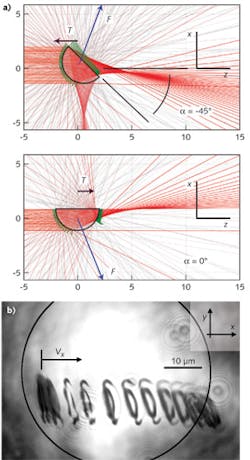OPTICAL FORCE PHENOMENA: Refractive object generates stable optical lift

Rochester Institute of Technology (RIT; Rochester, NY) researchers have mathematically predicted and experimentally observed the optical equivalent of aerodynamic lift. Unlike optical tweezers that require an optical gradient to trap a dielectric particle, say, in the waist of a focused laser beam, and translate that particle along the beam transmission axis via scattering forces, the generation of optical lift does not require a gradient. Instead, the RIT researchers explored the transverse lift of a dielectric object due to uniform illumination with negligible gradient force.1 The demonstration has future implications for improved interstellar space travel or for applying noncontact forces to microscopic particles using gradient-free optical sail designs.
A basis in theory
The Kutta-Joukowski theorem of aerodynamic lift supports the concept of optical lift through reflection and refraction of light over cambered or arc-shaped surfaces called light foils. Using numerical computations of the radiation pressure exerted on arbitrarily shaped objects through ray-tracing techniques and public-domain software, the force and torque could be determined as a function of the angle of attack for a uniform light beam (see figure). The calculations predict that 10 to 20% of the incident beam momentum can be converted to a stable lift force for a dielectric rod with a semicircular cross section.
To verify optical lift in a laboratory setting, the researchers experimented with microscopic light foils fabricated at RIT's Semiconductor and Microfabrication Laboratory. The rods were fabricated by melting rectangular rods of photoresist material on a silicon surface to round the top into an arc through surface tension. Tens of hemicylinders, measuring roughly 6 (base) × 4 (height) × 14 μm (length), were sunk to the bottom of a glass tank filled with water. Collimated laser light at a 975 nm wavelength with a 50 μm beam diameter was directed vertically upward through the bottom of the tank in the z direction.
Confirming optical lift
At a 130 mW optical power level, a single rod was rotated to a stable angle as predicted and then underwent lift and levitation. Transverse velocity vx reached values of 3.5 μm/s (a maximum when in the region of highest power density for the beam), while lift velocity was around 2.5 μm/s, resulting in a lift angle of 55°. The transverse lift force and forward scattering force could be optimized using more uniform semicircular rods.
"This work reminds me of the early days of flight or rocketry, only better: these early systems were plagued with stability difficulties and the Wright brothers and Robert Goddard spent considerable time learning to overcome catastrophic instabilities," says RIT associate professor Grover A. Swartzlander, Jr. "Fortunately, the lightfoils we designed are remarkably stable. As we continue to design more complicated special purpose lightfoils, such as for steering solar sails, stability will be a primary concern. We will also seek to optimize the lift-to-mass ratio of the lightfoil."
REFERENCE
1. G.A. Swartzlander, Jr. et al., Nat. Photon. online; doi: 10.1038/NPHOTON.2010.266 (Dec. 5, 2010).

Gail Overton | Senior Editor (2004-2020)
Gail has more than 30 years of engineering, marketing, product management, and editorial experience in the photonics and optical communications industry. Before joining the staff at Laser Focus World in 2004, she held many product management and product marketing roles in the fiber-optics industry, most notably at Hughes (El Segundo, CA), GTE Labs (Waltham, MA), Corning (Corning, NY), Photon Kinetics (Beaverton, OR), and Newport Corporation (Irvine, CA). During her marketing career, Gail published articles in WDM Solutions and Sensors magazine and traveled internationally to conduct product and sales training. Gail received her BS degree in physics, with an emphasis in optics, from San Diego State University in San Diego, CA in May 1986.